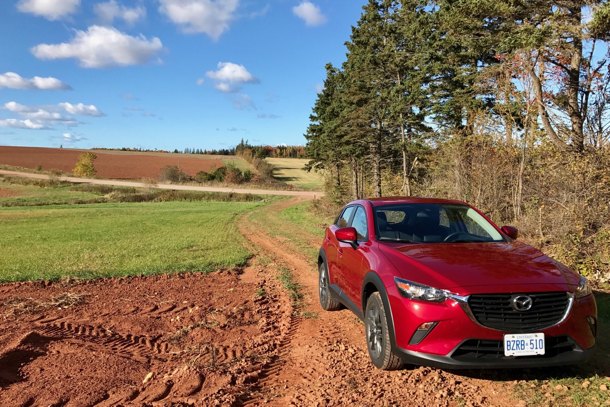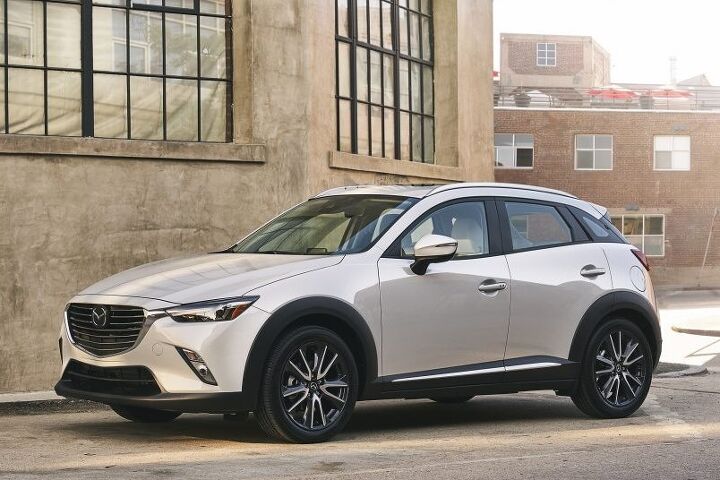#2018MazdaCX-3
2018 Mazda CX-3 GX Manual Review - Three Pedals Only Enhance the CX-3's Best Characteristics
Does it matter that I think it’s a hatchback? In the minds of the consumers Mazda is targeting, the modestly updated 2018 Mazda CX-3 is a crossover, an ess-you-vee, a utility vehicle.
We ought to make some allowance for the designation differences. The Mazda CX-3 offers all-wheel drive. The wheelarches are cladded in black plastic. The loftier ride height creates 6.1 inches of ground clearance, up from 5.5 inches in the Toyota Yaris iA, which is essentially a Toyota-branded sedan version of the latest Mazda 2 (that’s never been sold in the United States) on which the CX-3 is also based.
Let’s give in to Mazda’s marketing for a moment, then. If the CX-3 “may lead to spontaneous excursions,” how will it respond to a harvest season visit into Prince Edward Island’s endless reserve of potato fields?
To make matters more interesting, our CX-3 steed lacks Mazda’s optional all-wheel drive as well as Mazda USA’s standard automatic transmission. Count’em: there are three pedals.
Mazda CX-3 Wants to Save the Manuals, Too
Every Sunday or Monday, a very generous man appears in my driveway with a new car. The same man, in not as generous a fashion, also removes a car from my driveway. The most recent exchange involved the arrival of a fourth-generation 2018 Kia Rio and the departure of the 2018 Mercedes-Benz E400 4Matic Coupe we reviewed last week.
“Chilly one today, eh?” I say.
“I’m preparing myself for some cold days in PEI this winter,” Mr. Sowerby says with a chuckle. We chat for a moment about a recent Chevrolet Traverse event that was slathered across my Twitter feed, and as Garry gets into the Mercedes-Benz to depart he says, “You’re getting a Mazda CX-3 with a six-speed stick next week.”
Huh? It can’t be. Seriously?
For real.
2018 Mazda CX-3 Is Better, But Until It's Bigger, Better Probably Isn't Good Enough
Accompanied by a modest price increase of $150, Mazda’s first-generation CX-3 undergoes numerous under-the-skin updates for the subcompact crossover’s third model year.
Mazda’s Smart City Brake Support is now standard across all 2018 CX-3s. G-Vectoring Control, a nifty piece of software that sharpens steering response while reducing driver effort, is also standard on every 2018 Mazda CX-3. Mid-grade CX-3 Tourings are now equipped with auto headlights, auto climate control, and rain-sensing wipers.
Thicker glass, more sound deadening, and improved door seals bolster every CX-3’s refinement quotient. Mazda has also altered the suspension tuning of all CX-3s for the 2018 model year. Mazda claims revised bushings, new front lower control arms, recalibrated dampers, and new engine mounts will improve the CX-3’s “already class-leading chassis dynamics.”
Mazda’s probably not wrong. The 2016-2017 CX-3 was an exceptionally pleasing subcompact crossover to drive. And on that particular subject — on-road behavior — we’re apt to trust Mazda when the company says the refreshed model will be even better. But this is just a refresh, and an invisible refresh at that. As a result, the Mazda CX-3 has the same limitations for MY2018 that it had before, the kind of limitations that severely cramp demand.
It’s very small.


















Recent Comments